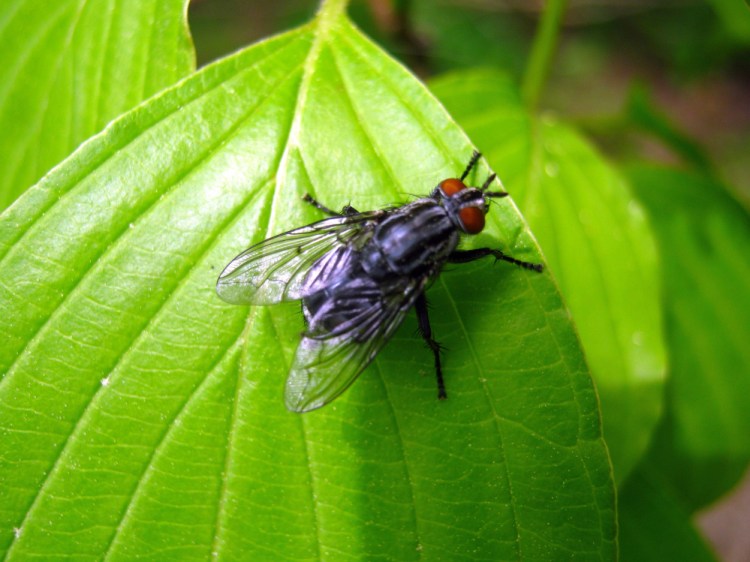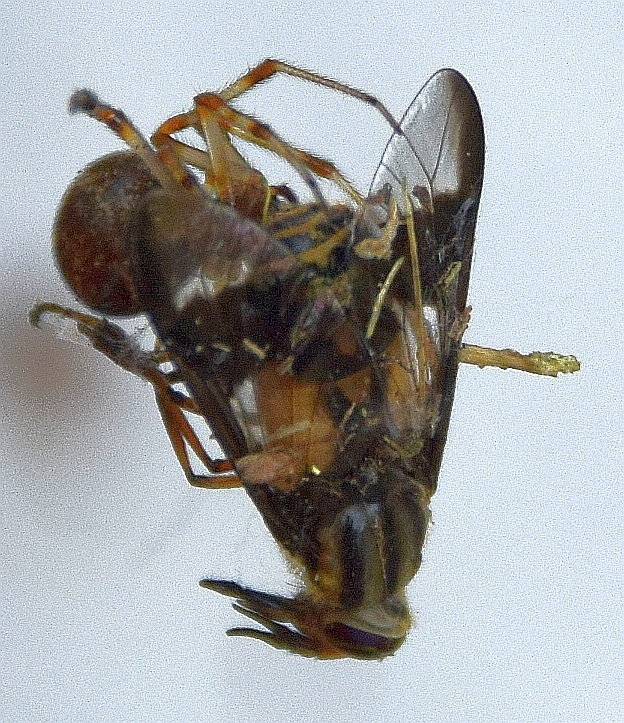Right inside June and July’s explosion of roses, bedstraws, buttercups, stitchwort, yellow rocket, crown vetch, sumac blossoms and frondlike grasses, like you were living in some demented David Lynch film, the walk up the driveway transforms to a freakish underworld nightmare.
The natural history of it begins, as a matter of fact, in mid-May here in Troy. Crabapple blossoms, yes, and violets, unfurling fiddleheads and brakes. But out of the woods at the same time come black flies. Big joke for people who live downtown or aren’t trying to plant gardens, but not all that funny in reality. Conditions in our yard are ideal for the little bastards — under the driveway runs a brook perfectly suited to their egg-laying, hatching and maturing routines. When they grow to adulthood, the females need “a blood meal” (as the entomologists put it with innocent morbidity) to foster the reproduction cycle. So they try to eat whoever walks past, intending to get the mail. You can carry around welts from the bites for days. Black flies (Simuliidae family) are quick, alert and hard to kill.
So they can wreck the relief you feel that warm weather has finally returned. On the bright side, they don’t last that long. This year they started out unusually strong, but suddenly one day were noticeably less numerous — right on the heels of a late frost which I theorize visited apocalypse on this year’s population. Anyway, they’re usually gone, for the most part, by May 31.
Then exactly on June 1 (so it seems), mosquitoes arise. They’ve used standing water, rather than running, to turn into tiny monsters. They get thick if I procrastinate cutting the grass. Most mosquito species (Culicidae family) in Maine occupy woodland areas, UMaine Cooperative Extension explains, but there are also urban and salt marsh species. Some of them carry West Nile virus, and all of them buzz around your ears in bed at night, as the females (again) are out for blood. Everyone knows the welts the bites leave — which aren’t technically bites, but prickings of the needle-like snout. I have to tell you, though, Maine mosquito bites are like, well, mosquito bites compared to the welts and swellings left by the flying thugs that tore into my hands and neck when I lived in Shanghai — I woke up several times with knuckles literally swollen stiff, sometimes lasting for days.
So Maine’s black flies are jokes that aren’t funny at the time, and mosquitoes are famous pests of woods and marsh areas. But nobody who doesn’t live in the woods says much of anything about the deerflies (Chrysops callidus). They’re summer’s unsung outlaws. If the walk up the driveway was a slapfest in May and June, it is a full-on “Blue Velvet” gantlet of miniaturized hell right underneath July’s verdant beauty.
Deerflies are sneakier than black flies and mosquitoes, and turn up along the driveway on no particular date, but by surprise attack sometime in July usually. Whether deerflies whirl around like devils or devils whirl around like deerflies, I don’t know. They’re the light-colored, medium-sized ones with mottled transparent wings. They lay their eggs near the brook. And it’s once again the females who are the predators (the males feed on pollen). They tear into human flesh with long, knifelike mouth parts and consume the blood. The bite can be as sharp as a bee sting, and the saliva that goes with the process can turn the wound into an ugly, swollen, painful itch. A bloody wound is also apt to attract filth flies, which include houseflies, blowflies (such as blue and green bottle), and flesh flies, all of which process decaying flesh, feces or garbage in one way or another.
The deerflies’ larger Tabanidae-family cousins the horseflies take the same basic approach to tearing off their ounce of flesh, but they’re usually less numerous up and down our driveway. I’m not sure why, and to tell you the truth I don’t care, either, because even if I knew, it wouldn’t help — by most accounts they’re all difficult to control. They’ll travel 20 or 30 miles to breeding grounds, and like the most effective agents of evil, they don’t keep still, so it’s hard to get a shot at them with insecticide. Deerflies in my experience are not quick on the uptake and can be slapped to death more easily than other kinds of flies, but by the time you feel them ripping into your skin, it’s too late anyway.
Also nasty enough for Thoreau to complain about are the no-see-ums, or biting midges, sometimes called punkies (Culicoides species). They show up here mainly in midsummer, and while they’re definitely pesky (”Females are vicious biters,” one guide remarks, camouflaging subjective judgment in scientific concision), they are in some minor league of blood-feasting compared to deerflies.
At least, that’s our experience in Troy of one of nature’s dimensions that could be the premise for a horror movie. Right in the dark cracks of summer’s godlike beauty.
Dana Wilde lives in Troy. You can contact him at naturalist1@dwildepress.net. His recent book is “Summer to Fall: Notes and Numina from the Maine Woods” available from North Country Press. Backyard Naturalist appears the second and fourth Thursdays each month.
Send questions/comments to the editors.





Success. Please wait for the page to reload. If the page does not reload within 5 seconds, please refresh the page.
Enter your email and password to access comments.
Hi, to comment on stories you must . This profile is in addition to your subscription and website login.
Already have a commenting profile? .
Invalid username/password.
Please check your email to confirm and complete your registration.
Only subscribers are eligible to post comments. Please subscribe or login first for digital access. Here’s why.
Use the form below to reset your password. When you've submitted your account email, we will send an email with a reset code.